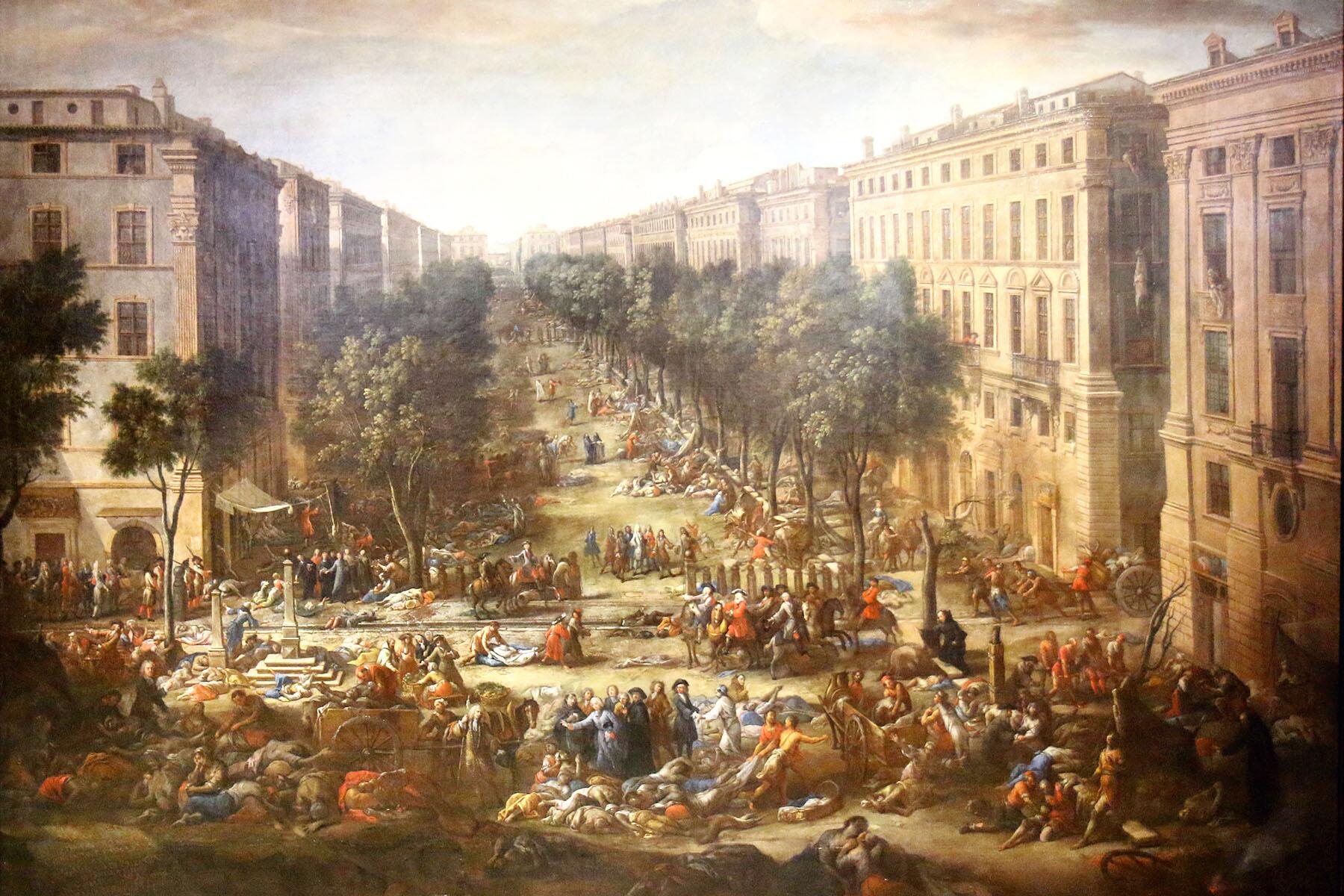You think we have it bad…
COVID-19 may be the first pandemic that we’ve personally experienced, but global outbreaks of disease have been around since the beginning of time. While they’ve devastated populations, they’ve also altered world history, spawned management techniques (hello, social distancing), and even provided lessons—most importantly that life does go on. Here’s a look at some of the world’s most infamous plagues and pandemics, and how each one finally got out of the mess.
Hamin Mangha Epidemic (circa 3000 BC)
In 2015, the charred remains of 97 people—aged between 19 and 35—were found stuffed inside a tiny ancient house in Inner Mongolia, China. Similar ancient sites were discovered nearby, making archaeologists think that they relate to a massive outbreak of infectious disease—the first known existence of any deadly prehistoric pestilence. The living were so intent on escaping that they never buried the dead. Today the site, known as Hamin Mangha, is the largest and best-preserved prehistoric site in northeastern China.
Plague of Athens (430-426 BC)
As the war between Athens and Sparta exploded in 430 BC, Athenians confronted an undesirable foe. People in good health, as described by Greek historian Thucydides, all of a sudden were “attacked by violent heats in the head, and redness and inflammation in the eyes, the inward parts, such as the throat or tongue, became bloody and emitting an unnatural and fetid breath.” Perhaps it was measles, Ebola, typhoid fever, or something else. Whatever the case, even though the epidemic killed a third of the population, the fighting went on, with Sparta finally triumphing over Athens. The epidemic—the most lethal in Classical Greek history—spread to the rest of Greece and the eastern Mediterranean before finally dying out in 426 BC.
Recommended Fodor’s Video
The Justinian Plague (541 AD)
Justinian I has the black rat to thank for the pandemic that ravaged his Byzantine Empire in the sixth century AD. Grain ships from Egypt carrying pestilent-laden rodents spread the disease via warehouses where the plague thrived. When it arrived in Constantinople in 541 AD, roughly 300,000 people perished that first year. Remember, that was about the time Justinian was trying to restore the glory of the Roman Empire, and his economy and military were annihilated, effectively ushering in the Dark Ages. But those weren’t his only worries. This nasty, fast-acting disease started as a slight fever that quickly moved into swelling and black blisters filled with pus. The lucky ones fell into a deep coma and died, while the less fortunate suffered from delusions and paranoia. In the end, between 30 and 50 million people across three continents died—about half the world’s population. Survivors—including Justinian himself—obtained immunity, and eventually, the disease had nowhere else to spread.
The Black Death (1347-1351)
Twelve ships from the Black Sea docked in Sicily in 1347, kicking off one of the world’s most infamous pandemics. Most of the sailors aboard were dead, covered in pus-and-blood-filled black boils. The ships were quickly turned back to sea, but it was too late. As in Justinian’s plague, infested rats soon invaded the shore, spreading the super contagious disease—most likely bubonic plague—across Europe. In five years, more than 20 million people died, wiping out entire villages and towns. Physicians had no clue how to treat it, so they tried bloodletting and boil-lancing, along with superstitious remedies such as burning aromatic herbs. Venetians were able to slow its spread by isolating sailors until it was clear they were disease-free, usually about 40 days, or a quarantine—one of the world’s first practices of social distancing.
Smallpox (1492-1980)
Conquistadors brought more than horses and sugarcane to the New World. They also brought smallpox among other vicious diseases that decimated indigenous populations. While smallpox had ravaged populations in Asia, Europe, and Africa for millennia, killing 30 percent of its victims, it decimated the Incas and Aztecs who had no immunity—killing upward of 80 to 95 percent within the first 150 years of Columbus’s 1492 visit. Finally, in the late 18th century, a milkmaid shared some game-changing folk wisdom with English doctor Edward Jenner, that having caught the relatively mild cowpox from a cow, she was immune to smallpox. It took a while, but smallpox was declared officially eradicated worldwide in 1980, following a global vaccination campaign conducted by the World Health Organization.
The Italian Plague (1629-1631)
Northern Italy may have been the epicenter of Europe’s COVID-19 attack, but that’s not the first time the region experienced an outbreak of disease. Back in 1629, infected soldiers fighting the Thirty Years’ War brought bubonic plague (those rats again) to Mantua. From there, it spread to major cities including Venice, Milan, and Florence, and in two years, more than 280,000 people died in northern and central Italy. The Venetians fought it off by quarantining the diseased in “pest houses” and torching their clothes and possessions. But even that didn’t help much. A third of the city-state perished—likely deflating its importance on the world stage. On a happier note, the city of Ferrara didn’t have one single death. Why? Early-day health screenings for all visitors entering the city walls, including proof of travel from a plague-free zone.
The Great Plague of London (1665-1666)
London suffered an onslaught of plagues in the 16th and 17th centuries, though the worst hands-down occurred between 1665 and 1666. In this blatant showcase of the “haves” and “have nots,” the rich—including King Charles II himself—fled the cramped city, leaving the poor to deal with the deadly, bubonic blitz. The instant someone got sick, their house was sealed, thereby condemning all family members to death. Red crosses were painted on their doors with the words: “Lord have mercy upon us.” Interestingly, it’s believed that another tragedy, the Great Fire of 1666, is responsible for finally stopping the pandemic. Nearly 90 percent of London’s houses were burned down, effectively obliterating the disease. But not before 75,000 to 100,000 people succumbed.
The Great Plague of Marseille (1720)
While air travel precipitated COVID-19’s global spread, ship travel was the culprit in earlier years. And so it’s no wonder that a prosperous port city like Marseille experienced one of the world’s most devastating pandemics, in 1720 when a merchant ship carried infected passengers from the Middle East. The ship was quarantined as protocol demanded (they’d been through this before), but its owner—who, by the way, happened to also be Marseille’s deputy mayor—convinced health officials to let him unload his cargo; he had a trade show to attend to sell his wares. Big mistake. Sick sailors spread the disease, sending nearly half of the city’s population to their writhing, boil-induced deaths. In nearby Provence, officials built plague walls in an attempt to ward off disease. Alas, it was too late—the plague spilled over into the surrounding countryside and infected thousands throughout southern France. It only stopped after it had run its course.
The Great Britain Cholera Pandemic (1854)
It may have been around for millennia and caused seven global pandemics killing millions of people, but one of the worst cases of cholera exploded in Great Britain in 1854, when it took down 23,000 people in the disease’s worst single year. At the time, people believed that foul air (“miasma”) caused this lethal disease. Thank goodness for Dr. John Snow, who realized that everyone afflicted had something in common: They drank water from the local Broad Street pump. He ordered the pump to be turned off, and the illness “magically” abated; his assessment that poor sanitation being the source was spot on. While cholera has been wiped out in developed countries, it remains a beastly threat in impoverished, less-developed nations threatened, with annual fatalities still ranging from 21,000 to 143,000.
Third Plague Pandemic (1855-1960)
If you’re counting, the world’s first two major bubonic plagues began with the Justinian Plague and the Black Death. Enter the “Third Pandemic,” the pandemic that ambushed the Chinese province of Yunnan in 1855. From there, it spread to the rest of the world on those darned rats via steamships. While this episode of the bubonic plague wreaked havoc, especially in India and China, it also provided the opportunity for doctors to figure out what was going on. In 1894, Dr. Alexandre Yersin of Hong Kong isolated the culprit bacterium—which spreads to humans via rat flea bites. In the end, more than 15 million lives were taken before it finally petered out in 1960.





